Do you have a question about the Goodman AVPTC42D14 series and is the answer not in the manual?
Key safety precautions including high voltage, proper installation, and avoiding hazardous materials.
Inspect unit for parts, follow handling guidelines, and adhere to codes and regulations.
Ensure readiness with proper preparation, system matching, tubing, and clearance requirements.
Instructions for upflow orientation, including drip shield removal and drain connections.
Details for horizontal left orientation, including primary and secondary drain connections.
Procedure for downflow/horizontal right installation, requiring a downflow kit.
Selecting tubing size and preparing ends for leak-free refrigerant line connections.
Step-by-step instructions for connecting refrigerant lines on TXV models.
Requirements for supply and return ductwork, including sizing and sealing.
Perform inspection, select wire size, and ensure proper overcurrent protection.
Details on making supply voltage connections through knockouts using copper conductors.
Connecting thermostat and dehumidistat wires to the integrated control module.
Adjusting blower speed and airflow using DIP switches for cooling and fan-only modes.
Setting electric heating airflow using DIP switches based on heater kit kW rating.
Protecting components from ESD and using diagnostic charts for troubleshooting.
Understanding ComfortNet system communication, wiring, and thermostat connections.
Accessing advanced features, diagnostics, and troubleshooting for the ComfortNet system.
Accessing and configuring advanced features, diagnostics, and system status.
Viewing fault history, model, serial number, and software revision.
Identifying operational issues based on LED codes, thermostat messages, and diagnostic charts.
Diagnosing system faults related to power, network communication, and data errors.
Troubleshooting blower motor run, communication, mismatch, limits, and trip faults.
Addressing motor voltage issues, parameter errors, and low airflow conditions.
Electrical connection diagrams for the air handler and integrated control module.
Wiring diagram specific to the installation of a 3-phase heat kit.
Guidance on filter replacement, compressor, and fan motor maintenance.
Cleaning outdoor coils and performing pre-servicer checks for troubleshooting.
Key safety precautions including high voltage, proper installation, and avoiding hazardous materials.
Inspect unit for parts, follow handling guidelines, and adhere to codes and regulations.
Ensure readiness with proper preparation, system matching, tubing, and clearance requirements.
Instructions for upflow orientation, including drip shield removal and drain connections.
Details for horizontal left orientation, including primary and secondary drain connections.
Procedure for downflow/horizontal right installation, requiring a downflow kit.
Selecting tubing size and preparing ends for leak-free refrigerant line connections.
Step-by-step instructions for connecting refrigerant lines on TXV models.
Requirements for supply and return ductwork, including sizing and sealing.
Perform inspection, select wire size, and ensure proper overcurrent protection.
Details on making supply voltage connections through knockouts using copper conductors.
Connecting thermostat and dehumidistat wires to the integrated control module.
Adjusting blower speed and airflow using DIP switches for cooling and fan-only modes.
Setting electric heating airflow using DIP switches based on heater kit kW rating.
Protecting components from ESD and using diagnostic charts for troubleshooting.
Understanding ComfortNet system communication, wiring, and thermostat connections.
Accessing advanced features, diagnostics, and troubleshooting for the ComfortNet system.
Accessing and configuring advanced features, diagnostics, and system status.
Viewing fault history, model, serial number, and software revision.
Identifying operational issues based on LED codes, thermostat messages, and diagnostic charts.
Diagnosing system faults related to power, network communication, and data errors.
Troubleshooting blower motor run, communication, mismatch, limits, and trip faults.
Addressing motor voltage issues, parameter errors, and low airflow conditions.
Electrical connection diagrams for the air handler and integrated control module.
Wiring diagram specific to the installation of a 3-phase heat kit.
Guidance on filter replacement, compressor, and fan motor maintenance.
Cleaning outdoor coils and performing pre-servicer checks for troubleshooting.
| Model | AVPTC42D14 series |
|---|---|
| Cooling Capacity | 3.5 Ton |
| Refrigerant | R-410A |
| Nominal Airflow | 1400 CFM |
| Voltage | 208-230 V |
| Phase | 1 |
| Cabinet Type | Foil-faced Insulation |
| Width | 21 inches |
| Depth | 21 inches |
| Type | Air Handler |
| CFM | 1400 CFM |
| Maximum External Static Pressure | 0.5 in. w.c. |
| Heating Capacity | 42, 000 BTU/h |
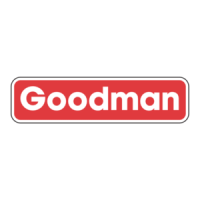


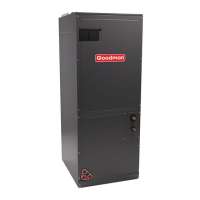
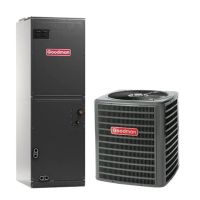
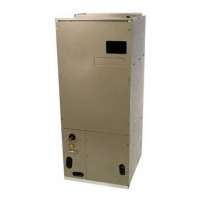





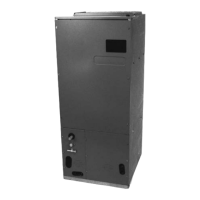
